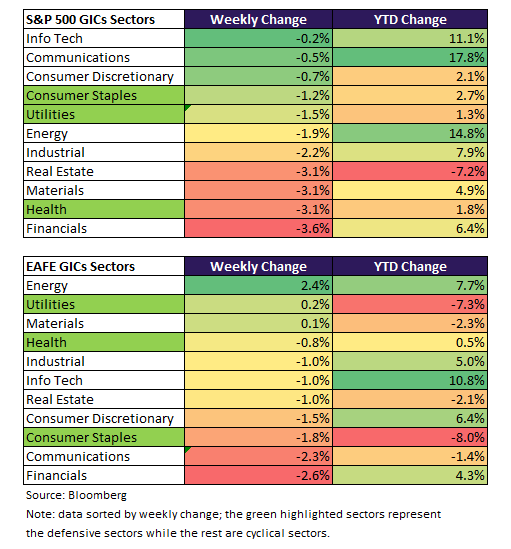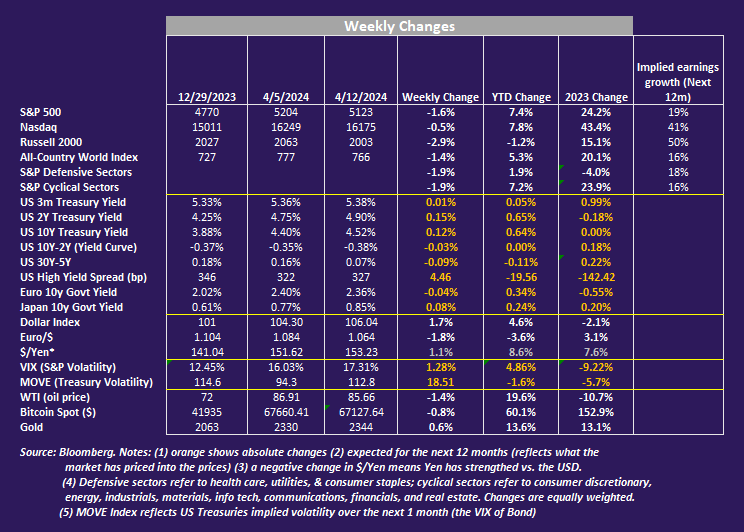Weekly Good Reads: 5-1-1
Diverging Interest Rate Paths, Debt Sustainability, World Growth, Fixing Things, Critical Materials
Welcome to Weekly Good Reads 5-1-1 by Marianne O, a 25-year investment practitioner and the author of
on investing, economy, and wellness in an intuitive voice. All the Weeklies are here, and here is the index of charts and terms. You can easily subscribe to my newsletter by clicking below.Please also check out my conversations with Female Fund Managers and Investors - new this year!
Thank you so much for your support🙏.
Market and Data Comments
This week’s market volatility concentrated on the bond side, where the MOVE Index jumped 18.5 points (almost 20%) while the VIX inched up 1.7 points to 17.3% for the week.
US Government bond yield leapt 12-15 bp (10y and 2y) but European government bond declined 8bp, showing divergent expectations of interest rate paths. What happened?
The US March headline and core inflation rose 0.4% m/m (3.5% y/y and 3.8% respectively), higher than expected due to core services inflation rising faster than expected. However, March PPI rose 0.2% m/m (a slower pace than February).
With the mix of CPI and PPI data, core PCE inflation, the preferred Fed’s inflation gauge, could be more modest than CPI and can slow to 2.6% y/y by June, when an interest rate cut is still possible, but this base case is getting more uncertain according to Bloomberg.
Note how the orange line (y/y change in core PCE) in the chart below has been trending down, likely hitting the low point in June.
Many Wall Street forecasters threw in the towel, beginning Wednesday, on their projection that the Fed would cut rates in June or that officials would make three cuts this year.
Economists at Goldman Sachs and UBS now see two cuts starting in July and September, respectively. Analysts at Barclays and Deutsche Bank anticipate just one reduction, in September and December, respectively.~ WSJ (see Econ/Invest #1)
The market has aggressively reassessed after the sticky and robust March CPI print and is now pricing in 1 to 2 interest cuts this year (see chart above) (lower than the 3 cuts implied from the March Fed’s Dot Plot median interest rate path).
In contrast, the ECB is saying the fundamentals (inflation cause, consumption, investment, political regime, and fiscal policy) of the EU and the US are different.
The EU core inflation is more likely to hit the 2% target earlier than in the US, showing a June interest rate cut is likely.
The Bank of England may also cut by June as both labour market and corporate credit demand are soft.
Three aspects of the macro backdrop are worth noting:
(1) Rising geopolitical tensions as the Middle East war attacks and tension and the continuous Russia-Ukraine conflict have boosted stocks volatility (VIX briefly touched 19% on Friday), raising gold and oil prices, and the demand for the US dollar.
(2) Slowing 5-year forward global GDP growth expectation — as IMF has pointed out, its 5-year ahead GDP growth estimate fell from 4% to 3% currently (i.e. expected global real GDP growth of 3% by 2029).
Persistently high interest rates and lower growth scenarios (caused by slower total factor productivity than before) will threaten debt/fiscal sustainability and could keep risk premia high and also raise risks for weak banks’ survival.
In Econ/Invest. #3 below, you can see the gross debt of both developed and developing countries have resumed their rise in 2023, with the US fiscal path deteriorating the most significantly.
The Budget Office forecasted the federal debt (if the trend persists) will rise to 116% by 2034 and 172% by 2054 (2023 US fiscal deficit reached 6.2%, in a growth year)! The main culprits are the high and rising mandatory spending and interest costs relative to the size of the economy.
(3) In US Treasury Secretary, Janet Yellen’s recent trip to China, she “insisted China address its industrial overcapacity issues relating to new-energy vehicles and solar modules and not a repeat of what happened when China’s below-cost steel flooded into the global market a decade ago”, as SCMP reported.
China has been addressing its economic slowdown by emphasizing supply-side expansion such as state-championed investment in cutting-edge technology and renewable energy rather than stimulating weak private consumption and consumer confidence.
Excess savings by the households (no safety net) and too much emphasis by the government on industrial policy rather than stimulating domestic demand could reduce China’s potential economic growth.
has a term for this: “Given the glut of 100 mm empty homes, what if China gives up on Real Estate anyway and targets another sector to channel its Top-Down GDP Targeting stimulus?The Gretaverse — a term I coined for the economically unrealistic Energy Transition/Green Energy—appears to be that sector.”
In fact, since the onset of US-China trade tension in 2017, China has overall gained global exports market share from 12.9% in 2017 to around 14% in 2023 (e.g. renewable energy segments growth), with Chinese exports shifting away from the US to Russia and other export destinations for its components before re-routing to the US.
This coming week, we will monitor the Spring meeting of the IMF/World Bank, the March US retail sales on Monday and the industrial production on Tuesday, the Euro area February industrial production on Tuesday, the UK March CPI on Wednesday, the March Japan CPI on Friday, and China’s March industrial production, fixed investment, retail sales, and Q1 real GDP on Tuesday.
Economy and Investments (Links):
Fed Rate Cuts Are Now a Matter of If, Not Just When (WSJ or via Archive)
The European Central Bank Might Beat the Fed to Interest Rate Cuts (Axios)
The Tree of Debt Must Stop Growing (FT or via Archive)
Finance/Wealth (Link):
What I Learned from Daniel Kahneman (Jason Zweig)
Once Danny taught me how unreliable the human mind is, I came to believe that everything in investing that can be done with rules, policies and procedures should be.
Instead of trying to guess when to invest how much in what, take your emotions out of the equation: Use dollar-cost averaging to invest a fixed amount every month.
Instead of buying based on your gut feelings or other people’s hunches, use a checklist that permits you to buy only if the asset meets a set of objective standards. Keep records of all your forecasts, so you can’t lie to yourself.
Track the returns of the assets you sold, as well as those you hold, to learn if you’re any good at trading. Always count your gains and losses not in isolation, but in proportion to your total assets.~Jason Zweig
Wellness/Idea (Link)
The 12 Ultimate Hero Foods: How to Improve Your Meals in Seconds - Without Really Trying (The Guardian)
+ How to Fix Your Stuff (Vox) - important, please read!
Before you rush out to buy a new item to replace your broken one, check out iFixit, an online database of user-generated repair guides.
An anecdote to share: my laptop keys have been malfunctioning, and instead of rushing to buy a new laptop, I plugged in an old desktop keyboard at home and an Apple iPad keyboard when I travel with my laptop. That operation saved me lots of money!
One Chart You Should Not Miss: Critical Materials and Critical Minerals
As defined by the U.S. Department of Energy under the 2023 DOE Critical Materials Assessment:
critical materials are those that run a high risk of supply chain disruption and are essential in one or more energy technologies.
critical minerals are any mineral, element, substance, or material designated as critical by the Secretary of the Interior.
The charts below show those critical materials/minerals (red) in the short and medium terms.
12 out of the 18 critical materials for energy, assessed by Morgan Stanley, depend on China to some extent.
The US has taken several steps to reduce its supply-chain reliance on China by incentivizing domestic investment in the manufacturing of technology key to energy transition (The Inflation Reduction Act) and national security (CHIPS+Act).
One Term To Know: AGI
I don’t mean “Artificial General Intelligence”, which is the term for another day!
It is the good old Adjusted Gross Income in the US tax returns.
According to the Internal Revenue Service:
Adjusted gross income (AGI) is defined as total income minus deductions, or "adjustments" to income you are qualified to take [Gross income - Adjustments]:
Gross income includes wages, dividends, capital gains, business and retirement income and all other forms of income.
Examples are tips, rents, interest, stock dividends, etc.
Adjustments to income are deductions that reduce total income to arrive at AGI.
Adjustments include half of the self-employment taxes; self-employed health insurance premiums; contributions to certain retirement accounts (such as a traditional IRA); student loan interest paid; educator expenses, etc.
The IRS has a list of items that help to lower AGI, which is listed on the second page of Schedule 1 of Form 1040 (Federal Tax Return), and the IRS tells you how to lower AGI here: e.g. Contribute to a Health Savings Account, claim educator expenses if they’re a qualifying educator, save in a retirement account, etc.
One common myth that the IRS clarifies: do people have to report when receiving money from Family and Friends??
Myth: People will get a Form 1099-K from friends and family sending them personal payments.
Fact: Payments from friends and family should generally not be reported on a Form 1099-K. Form 1099-K reports payments for goods or services and should not report personal payments like rent, dinner, travel and other gifts or reimbursements gifts, no matter the amount. Generally, in payment apps, the default is personal payments unless the sender designates that they’re purchasing goods or services, or it is designated a business account.~ IRS
Please do not hesitate to get in touch if you have any questions!
Also please check out my Conversations with Female Investors and other changemakers.
If you like this Weekly, please share it with your friends or subscribe to my newsletter🤝.










